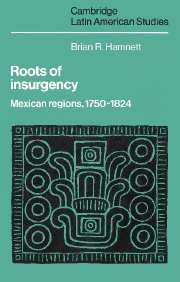Book contents
- Frontmatter
- Contents
- List of maps
- Acknowledgements
- Weights and measures
- Map 1 The viceroyalty of New Spain in 1810
- Introduction
- 1 Social tensions in the provinces
- 2 Insurgency — characteristics and responses
- 3 Conflict, protest and rebellion
- 4 Dearth and dislocation
- 5 Insurrection — recruitment and extension
- 6 The struggle for Puebla,1811–13
- 7 Local conflict and provincial chieftains
- 8 Conclusion
- Notes
- Bibliography
- Index
- CAMBRIDGE LATIN AMERICAN STUDIES
4 - Dearth and dislocation
Published online by Cambridge University Press: 20 October 2009
- Frontmatter
- Contents
- List of maps
- Acknowledgements
- Weights and measures
- Map 1 The viceroyalty of New Spain in 1810
- Introduction
- 1 Social tensions in the provinces
- 2 Insurgency — characteristics and responses
- 3 Conflict, protest and rebellion
- 4 Dearth and dislocation
- 5 Insurrection — recruitment and extension
- 6 The struggle for Puebla,1811–13
- 7 Local conflict and provincial chieftains
- 8 Conclusion
- Notes
- Bibliography
- Index
- CAMBRIDGE LATIN AMERICAN STUDIES
Summary
Dearth was not an exceptional occurrence, but part of the pattern of life in town as well as country in the era before the development of mechanised industry and the modernisation of the infrastructure. Appeals to the supernatural personalities to intervene, in order to stave off or bring to an end the disasters of the natural world recurred at frequent intervals. The predominance of agriculture in the economy did not provide the sole explanation for this unavoidable exposure to the vagaries of daily life. Meteorological fluctuations affected a variety of activities besides farming, since commerce and industry remained heavily dependent upon animal transportation and animal power. Altitude ensured that these uncertainties affected different regions, if not localities, in different ways. Primitive conditions of transportation and communication frustrated what efforts were made to bring relief supplies to the zones worst affected by shortage. In general, a rise in cereal prices would be transferred to all other foodstuffs, a factor which under famine conditions, prevented the substitution of one cereal for another, or of non-cereal foodstuffs for cereals. The most serious dearths followed the loss of two harvests, as in 1739–40, 1785–6 and 1808–09, and produced a ‘subsistence crisis’. This latter term may be convincingly used to describe the phenomena we are about to discuss, providing we appreciate beforehand that dearth did not of itself give rise to structural transformation in society or the economy. The ‘crisis’ concept is useful, then, to describe the very real and repeated struggle for existence on the part of ordinary people faced with the prospect of starvation.
- Type
- Chapter
- Information
- Roots of InsurgencyMexican Regions, 1750–1824, pp. 102 - 124Publisher: Cambridge University PressPrint publication year: 1986



